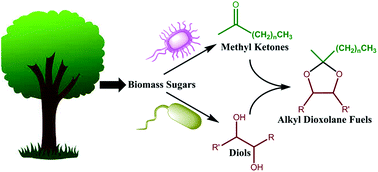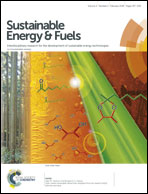High cetane renewable diesel fuels prepared from bio-based methyl ketones and diols†
Abstract
A new class of renewable diesel fuels has been synthesized by acid catalyzed condensation of 2-tridecanone with a series of diols that can be generated from biomass. These fuels exhibit comparable net heats of combustion (NHOCs) to conventional biodiesel, while maintaining derived cetane numbers between 82-91, values which are 20–30 units higher than conventional biodiesel and 40–50 units higher than petroleum-derived diesel fuel. The short combustion delays of the dioxolane fuels make them compelling blendstocks to enhance the combustion efficiency of petroleum-derived diesel fuel by increasing the cetane number and oxygen content of the blends. In addition, careful selection of the renewable diol allows for custom tailoring of viscosity and freezing point. Unlike conventional biodiesel which is often generated from plant or animal derived triglycerides, 2-tridecanone and other methyl ketones, along with the diols, can be efficiently generated from biomass sugars or CO2/H2via fermentation with metabolically engineered microorganisms. This biosynthetic approach may allow for the generation of these fuels on industrially relevant scales while eliminating competition with food sources and promoting responsible use of land resources.



 Please wait while we load your content...
Please wait while we load your content...